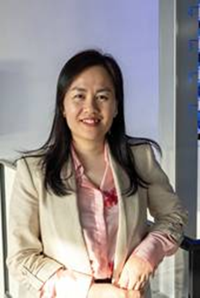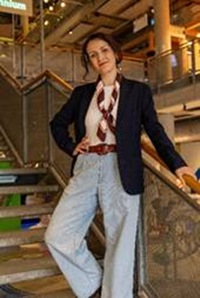Four female scientists have been honoured for their exceptional contribution to science. Two winners of this edition are UT scientists Dr.ir. Trang Duong (ET) and PhD Džemila Šero (EEMCS). During the For Women in Science award ceremony at NEMO Science Museum in Amsterdam, they each received an award worth €30,000 in the presence of State Secretary for Emancipation Mariëlle Paul to further develop their research in a fellowship at the Netherlands Institute for Advanced Study. Here, the laureates will spend five months in a community of international scientists.
The initiative of L'Oréal Groupe in the Benelux and the Dutch Unesco Commission, in collaboration with the Dutch Network of Women Professors (LNVH), the Netherlands Institute for Advanced Study (NIAS), and NEMO Science Museum aims to give female scientists the recognition they deserve and to encourage women and girls to pursue a career in science.
This year, for the first time, a secondary school was also invited to inspire young people to choose a future in science. "When girls meet female role models in science at a young age, they see that science is also an option for them. In this way, we open the way to a future in which talent and ambition determine who the discoverers of tomorrow are. Because the world needs science and science needs women," says Jean-Baptiste Dalle, Country Manager L'Oréal Benelux.
State Secretary Mariëlle Paul (Basic Education and Emancipation): "Female talent must also be able to succeed in science and technology. With their perspective, women can find new, original answers to the big questions of today and tomorrow. The For Women in Science awards put the spotlight on brilliant female scientists. They are a wonderful example for all girls who are thinking about what they want to become."
Four women in science
In Europe, less than 30% of professors are women. The Netherlands is even slightly below this average with 28.7%. We are still a long way from there in both the Life Sciences and the STEM disciplines (Science, Technology, Engineering & Mathematics).
The For Women in Science program was launched worldwide by L'Oréal Groupe and Unesco in 1998. Since its inception, the programme has supported more than 4400 female researchers, six of whom went on to win a Nobel Prize.
In the Netherlands, the programme has existed since 2012, in collaboration with the Dutch UNESCO Commission, the Netherlands Institute for Advanced Study (NIAS-KNAW) and the Dutch Network of Women Professors (LNVH). This year, NEMO Science Museum is also an official partner of the programme. Every two years, the programme awards four exceptional female scientists in the Netherlands with a research grant of €30,000 to further develop their groundbreaking innovations and their research.
Laureaten 2025
Below you will find more information about the UT winners and their groundbreaking research. The other winners are: Jolien Francken (University of Amsterdam) on 'A philosophical toolbox for neuroscientists' and Iris Walraven (Radboudumc) on 'Understandable AI for patients: Choosing lung cancer treatment with confidence'.
STEM-disciplines Trang Duong (University of Twente (ET) & IHE Delft)
Trang Duong (University of Twente (ET) & IHE Delft)
How knowledge about historical flooding can contribute to a safer future for coastal communities
Flooding caused by storms is a major danger for people living on the coast. Climate change and rising sea levels are only exacerbating this problem. With my research, supported by the For Women in Science Fellowship, I want to do something about this. With my experience in accurately simulating flood damage from severe storms, such as storm Xynthia that hit France in 2010, I now want to answer two questions: first, what would be the damage if such a storm were to occur again in the future, with the higher sea level, but without additional flood protection? And second, what additional measures would work best to limit damage? I am convinced that my research will provide crucial information for policymakers to make informed decisions about coastal zone management. My research will contribute to a Europe that is more resilient to climate change and to the development of smart strategies to protect vulnerable coastal areas worldwide.
Dr. Trang Duong's research on the resilience of coastal areas to climate change was recognised, among other things, for its international applicability. Her project is also notable for its practical relevance, especially now that sea levels and extreme weather events are increasing.

Džemila Šero (University of Twente (EEMCS)
Artists' fingerprints: AI helps analyse works of art
Artificial intelligence (AI) is becoming increasingly important in science, we see that everywhere. AI can also mean a lot in research into cultural heritage and art, but it is still little used there. There are opportunities, especially when analysing fingerprints on works of art. There is no standard way to collect and analyse those fingerprints yet, and AI is hardly used here. Computers can already handle damaged fingerprints on paper well, but these techniques are not yet used for art objects. With my For Women in Science Fellowship, I will therefore focus on the virtual analysis of fingerprints on terracotta objects. For that, I'm going to use the latest image processing technologies.
The jury selected Dr. Džemila Šero for her highly original research in Heritage Biometrics, in which she uses advanced scanning techniques to discover hidden traces of artists on centuries-old sculptures. Her pioneering combination of art history, forensic science and imaging technology opens a new chapter in the approach to cultural heritage.







